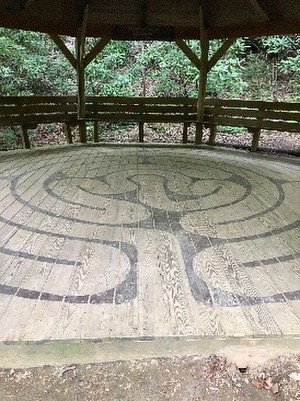Søren Kierkegaard once said, “Above all, do not lose your desire to walk: Every day I walk myself into a state of well-being and walk away from every illness; I have walked myself into my best thoughts. ...”[i] Many Christians find the practice of walking the labyrinth a useful tool in focusing their thoughts on God by means of physical movement. Just as some people find kneeling to be a helpful posture for prayer, others find that movement helps them center on the ways God guides them. Consider using the labyrinth as a means of leadership development and spiritual nurture as a ruling elder. It is a metaphor for the ways in which God has led us in the past and the promise of how God continues to lead us forward.
Walking the labyrinth is an ancient practice with variations found in numerous cultures throughout the world. It became an important means of spiritual formation to the Christian church during the Middle Ages. Because of the political turmoil in Palestine, it was no longer possible for European Christians to travel to Jerusalem, and as a result, many began seeking alternative ways to make this journey, even if they couldn’t physically accomplish it. The labyrinth was the solution to a different kind of pilgrimage.
I first experienced walking the labyrinth at a national youth conference of the Presbyterian Church (U.S.A.). A large canvas with the classic Chartres Cathedral pattern was laid out as part of a spirituality center. At first, I wondered what people found so compelling in this practice. I started off slowly, with an open and contemplative attitude. The twists and turns were at first pleasant. Then I started to become impatient. It seemed I had made nearly no progress at all, because as I rounded one more turn it seemed I was almost at the same place I was moments before. Hadn’t I been here before? It may have seemed that way, but in fact, I was further along. It was a metaphor for my own spiritual journey. Sometimes we experience the same lessons we had faced previously, while in fact, we are at a different place with more maturity with which to proceed with confidence and faith. Yes, sometimes what goes around comes around again, but we are further along in our own relationship with God and one another.

Walk Jones Wilderness Sanctuary and Labyrinth at Montreat Conference Center. Photo by Martha H. Miller
In 2002 I created a small labyrinth at Montreat Conference Center. I did so with the help of my then ten-year-old son. After we finished the project, he did what any ten-year-old might do—he ran the path like it was a racetrack. Then he walked it more slowly and thoughtfully. Then he did something I will never forget. He started at the opening of the labyrinth, ignored the path and said, “You know, Papa, some people think with just one prayer you can go straight to the center and miss all the curves. But that’s not the way it is in real life, is it?” “No,” I answered. “At least that’s not the way it is in my life or in the lives of most of the leaders and heroes we read about in the Bible. You don’t get to skip all the curves.”
Sometimes the labyrinth can be a surprising help when you are stuck—emotionally, spiritually, or intellectually. The kinesthetic movement actually assists in getting you “unstuck.” This can apply to you as an individual or as a community. Try walking the path while repeating to yourself, “One step at a time. One step at a time.” Pay attention to any phrases that pops into your mind as you move forward.
You may want to walk the labyrinth as a group. In her book, Living the Labyrinth, Jill Geoffrion suggests, “While walking the labyrinth with others try to perceive a part of yourself in each person. Open your heart to all those around you. Pray for the well being of each person.”[ii]
Finally, you may wish to choose a shared scripture or a shared question regarding the direction and challenges facing your congregation. For example, from Psalm 32:8, “I will instruct you and teach you in the way you should go; I will counsel you with my eye upon you.” May the labyrinth enrich your lives in ways that embody the love and wisdom of God.
If you don’t have access to a labyrinth to walk in your area, consider using a finger labyrinth. More information is available here with templates for finger labyrinths here.
The Reverend Jon Brown serves as pastor of Old Bergen Church, a multicultural congregation across the Hudson River in Jersey City, N.J. He has also served congregations in Charleston, S.C., Hendersonville, N.C., as program director at Montreat Conference Center, and as director for mission interpretation with the Presbyterian Mission Agency in Louisville, Ky.
